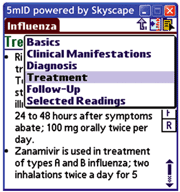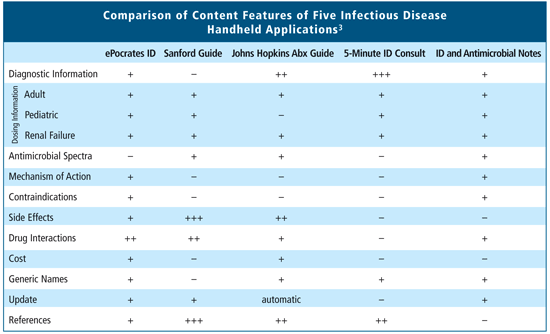Philippe L. Bedard, MD, and Feisal A. Adatia, MD, MSc, First Year Ophthalmology Resident; University of Toronto, Toronto, ON.
Many health care professionals use handheld computers to access medical reference information and drug databases at the point of care.1 There are many specific infectious disease software applications for handheld computers, which combine information regarding specific microbial pathogens and sites of infections with antimicrobial databases and treatment guidelines. Infectious disease software may minimize medication prescription errors and promote more rational use of antimicrobials. This article briefly reviews the salient features of five popular infectious disease applications.

ePocrates ID
ePocrates ID is available with ePocrates Rx Pro, the purchase-based suite which includes the popular handheld drug database, ePocrates Rx. Users can search by location, bug or drug. ePocrates ID provides a numbered list of recommended antimicrobial regimens for both empiric and specific pathogen-based therapy. For each antimicrobial, users can tap on a hyperlink to be connected with ePocrates Rx for more detailed drug monographs. ePocrates ID offers the simplest and most intuitive interface of any available infectious disease handheld application. Busy clinicians can quickly find treatment recommendations and a wide range of well-organized antimicrobial information at the point of care. However, users should be aware that the manufacturer of ePocrates has the ability to track how information is accessed on ePocrates ID.2 Another drawback is that ePocrates cannot be run from an expansion memory card. ePocrates Rx Pro is expensive and users must renew their subscription annually. Unlike the core drug database in ePocrates Rx, ePocrates ID is not automatically updated with each hotsync operation, although users can download quarterly updates.
 The Sanford 2003 Guide to Antimicrobial Therapy
The Sanford 2003 Guide to Antimicrobial Therapy
The Sanford Guide is the handheld version of the popular paper-based infectious disease handbook. The opening screen of the handheld version is split into a "rapid reference" section of 17 commonly used tables and a searchable alphabetical index. The Sanford Guide provides the most detailed coverage of antimicrobial spectra, adverse medication effects and drug interactions and the most extensive literature references. However, unlike other applications, the information in the Sanford Guide is not organized by individual drug monographs, making it difficult to find information about a particular antimicrobial or clinical infection quickly. The search feature in the Sanford Guide is also cumbersome, as scroll bars must be used extensively to find information.
Johns Hopkins Division of Infectious Diseases Antibiotic Guide
Information in this guide may be searched through three side tabs entitled diagnosis, pathogen or antibiotic. Of the reviewed programs, this is the only one which is free and that automatically updates when a handheld syncs with a desktop computer. While being quite comprehensive and having undergone vigorous review for accuracy, this program does not provide any pediatric dosing. As well, drug monographs cannot be accessed through diagnosis or pathogen tabs, adding time required to search for drug details.
 The 5-Minute Infectious Diseases Consult
The 5-Minute Infectious Diseases Consult
This program is one of the extensive catalogues of medical reference books available from Skyscape. For users of other Skyscape references, the link feature allowing cross-referencing of databases is an attractive benefit. There are four indices that can be searched: Main Index, Microorganisms, Medication Index and Table of Contents. The Main Index is organized into basics, clinical manifestations, diagnosis, treatment, follow-up and selected readings. Perhaps the best feature of this program is its speed and ease of navigation. It is the most expensive of the reviewed databases and provides less drug monograph information than the other alternatives.
Infectious Diseases and Antimicrobials Notes
This program is formatted to run in iSilo, an e-book reader. It has the following sections: antimicrobial spectra index, prophylactic therapy, normal flora, organisms and treatment, infectious disease and treatment and antimicrobial treatment. This program has several attractive features. Its prophylactic therapy section provides details on prevention of infection with chemotherapy and provides surgical antibiotic prophylaxis notes. Its inclusion of a normal flora section is also quite educational. However, it requires extensive scrolling and lacks sidebar tabs seen in other applications. Furthermore, it does not disclose author information or provide references for its citations.
Conclusion
There is a variety of alternatives for users in search of an infectious disease reference for their handheld computers. ePocrates ID and Johns Hopkins Division of Infectious Diseases Antibiotic Guide provide the most concise and easily navigable treatment guidelines for particular clinical scenarios. The Sanford 2003 Guide to Antimicrobial Therapy may be most appropriate for specialists well acquainted with the paper-based version of the guide. The 5-Minute Infectious Diseases Consult offers the most extensive diagnostic information and can be linked with other Skyscape applications. Finally, the Infectious Diseases and Antimicrobials Notes may appeal to those in search of information regarding microbial flora and antimicrobial prophylaxis.

References
- Adatia FA and Bedard PL. "Palm reading": 1. Handheld hardware and operating systems. CMAJ 2002;167:775-80.
- Adatia FA and Bedard PL. "Palm reading": 2. Handheld software for physicians. CMAJ 2003;168:727-34.
- Miller SM, Beattie MM, Butt AA. Personal digital assistant infectious diseases applications for health care professionals. Clin Infect Dis 2003;36:1018-29.